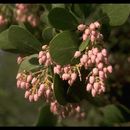Morphology
provided by EOL authors
Most of the taxa within the Arctostaphylos genus are evergreen, with Red bearberry and Alpine bearberry being exceptions. Plant height within this group varies between 70 centimeters and 600 centimeters, with architecture varying between erect to prostrate in form; moreover, many of the taxa are characterized by a fire-resistant basal burl. The bark color is generally reddish to orange, and while typically very smooth, some species have a distinctive shredding or peeling character. The simple, alternating leaves are spreading to ascending, and are sometimes convex. Leaf margins are flat to rolled. Although upper and lower leaf surfaces are sometimes similar, some species manifest ifferences in color or stomatal density in upper versus lower leaf surface. For example, coastal California taxa have stomata restricted to the lower leaf surface. The terminal inflorescences are panicle or raceme in form; moreover, flowers have bracts that may be either scale-like or leaf-like. The radially symmetric flowers typically have a five lobed corolla and five free and persistent sepals. Corollae are spheric to bowl shaped, and are most often white to pink. Most often there are ten stamens and two recurved awns. The ovary is superior, with base circumscribed by a nectar disk. Fruits are berry-like and approximately spheric, with generally thick, mealy pulp and two to ten stones.
Genus Abstract
provided by EOL authors
Arctostaphylos is a genus of plants in the family Ericaceae. This group of 109 shrubs and small trees has a center of biological diversity in the California Floristic Province, although a few of the bearberries are circumboreal and widespread. There are significant conservation issues for the genus, since many species have highly restricted distribution,and many are classified as rare or endangered species; over half of the taxa are classified as rare or endangered species by the California Native Plant Society. The evolution and taxonomy of the Arctostaphylos genus are complex issues, the subjects of which have recently been explored with genome sequencing analysis. The taxa in the genus generally have reddish or orange bark and mealy berry-like fruits. The genus evolution was likely centered in the far western part of North America, where fossil ancestors dating to the Middle Miocene are apparent. The genus was likely even more diversified as it evolved into the Early Tertiary. Evolution of genus Arctostaphylos likely shares a similar timeline with that of Ceanothus, which is another western North America genus that exhibits fire regenerative properties. Extensive use of the fruit and leaves were made by prehistoric peoples for culinary, medicinal and ceremonial purposes. While 96 of Arctostaphylos taxa are found in California, there are several species that are circumboreal in distribution. The most widespread species are Red, Alpine and Common bearberry; in fact Common bearberry, A.uva-ursi, is found in arctic and subarctic circumboreal regions, and their range extends south to higher altitude habitats in the Rocky Mountains in North America; and to the Grampians, Carpathians, Alps and Caucasus in Eurasia. Most of the species within the Arctostaphylos genus are evergreen, with Red bearberry and Alpine bearberry being exceptions. Plant height within this group varies between 30 centimeters and 600 centimeters, with architecture varying between erect to prostrate form; moreover, many of the taxa are characterized by a fire-resistant basal burl. The bark color is generally reddish to orange, and while typically very smooth, some species have a distinctive shredding or peeling character. The simple, alternating leaves are spreading to ascending, and are sometimes convex. Leaf margins are flat to rolled. Although upper and lower leaf surfaces are sometimes similar, some species manifest differences in color or stomatal density in upper versus lower leaf surface. For example, coastal California taxa have stomata restricted to the lower leaf surface. All taxa within the genus are hermaphroditic and insect pollinated. Flowers characteristically appear in the Northern Hemiisphere spring, with many coastal species blooming as early as winter, due to the mild conditions of coastal microclimates. Fruits develop in summer and endure for a long time well into autumn. The chaparral biome is considered classic habitat of the Arctostaphylos genus in its center of diversity; however, there are many California occurrences in forest settings especially oak woodland and savanna. In many cases the taxa are found on highly distinctive soil substrates which are notable in extreme pH, mineral content (especially ultramafic soils), high sand content, extreme surface compaction or other notable abiotic factors. Common chaparral associates are Prunus ilicifolia, Cercocarpus betuloides, rhamnus crocea, Rhamnus california, chamise, Toxicodendron diversilobum, and a wide variety of Ceanothus species. Arctostaphylos species are also a key component of communities which are transitional between chaparral and coastal sage scrub types.
- bibliographic citation
- C.Michael Hogan. 2012. Arctostaphylos. Eds. M.McGinley and C.J.Cleveland. Encyclopedia of Earth. National Council for Science and the Environment.
- author
- C. Michael Hogan (cmichaelhogan)

